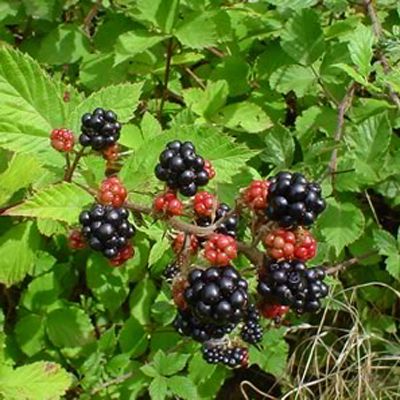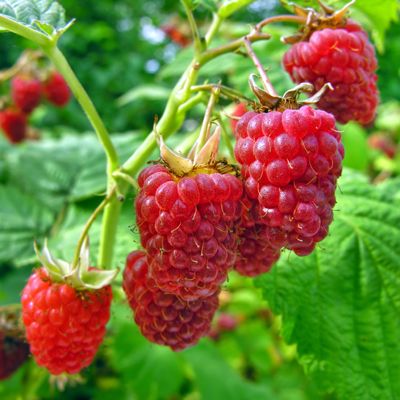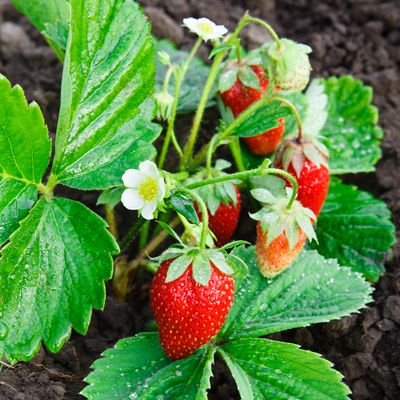


Caneberries & Strawberries (Blackberries and Raspberries)
You can grow a few caneberries in large containers. If you train them carefully along a fence or trellis and keep them pruned, they won’t take very much space.
When planted in the garden, caneberries will perform best in full sun. Six hours of direct sun would be a minimum. Amend the soil as needed with organic plant material such as Master Nursery® Gold Rush, Master Nursery® Bumper Crop or similar. The soil should be kept moist, but not soggy. Let the top two to three inches dry out before watering again. It is better to underwater caneberries than to overwater them because of their susceptibility to root rots.
Blackberries
Blackberries are planted four to six feet apart. Clip the canes to six inch stubs and plant to the soil level visible on the stubs. When new growth appears, remove and destroy any stubs which have not sprouted. Stiff caned blackberries need no support, but can be confined between two wires to save space. Blackberries bear fruit on canes that grew the previous season. When two year old canes are fruiting, new shoots are sprouting from the base. They bear the following year. Canes fruit only once. The object of pruning is to remove fruited canes and to select strong new canes. Trailing blackberries should be cut to the ground after fruiting. New growth that sprouts during the last part of summer will fruit the following year. Many gardeners will train trailing blackberries on a wire or trellis to get them off the ground.
Blackberry fruit sometimes gets hard and does not ripen. This is due to the redberry mite. Spray the plant with Sulfur, when the fruit starts to develop and then at two-week intervals.
Raspberries
Raspberries require the same growing conditions as blackberries. One crop (single crop) raspberries produce fruit on canes that grew the previous year. Two crop (ever-bearing) raspberries produce some fruit at the top of current season canes in fall and then produce a second crop on the rest of the cane, the following year. After fruiting in the second season, the canes die and can be cut to the ground. New canes start as shoots from the base of an old cane or as suckers from root-like underground stems.
As with all other trees and shrubs, mulch yearly or as needed with three to four inches of Master Nursery® Gold Rush, Gardener & Bloome® Soil Building Conditioner or fir barks. Experts differ on a fertilizer schedule so we will recommend the same as for deciduous fruit trees; Master Nursery® Fruit Tree and Vine Food about Valentine’s Day, Memorial Day and Labor Day.
Caneberries are relatively free of insect pests. If mites become a problem, spray with a sulfur solution such as Safer® Brand Garden Fungicide or prepare a solution from sulfur powder. Unfortunately, caneberries are very susceptible to Verticillium Wilt for which there is no cure. Therefore, do not plant them near Tomatoes, Potatoes, Eggplant or other members of the nightshade family or within 500 feet of plants which have died from Verticillium Wilt.
Among caneberries normally available are:
- Everbearing Raspberries: Heritage and Indian Summer
- Upright Blackberries: Brazos, Black Satin and Black Satin, Thornless
- Trailing Blackberries: Ollalie, Boysenberry, Thornless Boysenberry & Thornless Loganberry
All of these caneberries have been selected to grow and produce well in our area.
Strawberries
Strawberries require the same growing conditions as the caneberries. The soil with an inch or two of amendment should be tilled or spaded to a depth of about 8 inches. Plants need 1 to 2 inches of water per week. The soil should stay moist. Mulch to conserve water. The plants should be set in the ground with the top most roots one-quarter inch below the soil (exposed roots dry out and die) but no deeper (buried crowns rot). Fertilize plants twice a year, about Valentine’s Day and again after the first crop with Master Nursery® Fruit Tree & Vine Food, Master Nursery® Citrus Food or Gardner & Bloome® Citrus & Tree Fertilizer.
Strawberries may be planted on hills or the flat ground. The latter method is most simple and efficient. Set the plants out in alternating rows 10 to 18 inches apart. Pinch out all blossoms the first season. Allow runners to root anywhere within the bed. In autumn of second year, grub out about one-third of all plants, focusing on older and weaker plants. Do the same each year thereafter. After three or four years, renew the planting with fresh nursery stock.
Control mites with sulfur spray and aphids with Safer® Brand Insect Killing Soap or Ortho® MAX® Malathion Insect Spray. Do not use chemicals after fruit forms. Control snails, slugs and earwigs with Monterey Sluggo® Plus. Cover the beds with netting if birds become a problem. Strawberries are very susceptible to Verticillium Wilt, so when symptoms appear, discard the plants and start in another area for two or three years.
Many varieties of strawberries are available. In our mild climate, most behave as the “Everbearing” type. Sequoia and Tioga are long time favorites for Bay area gardeners. Also available are: Diamante, Quinault, Chandler, Fresca, Albion and Seascape.